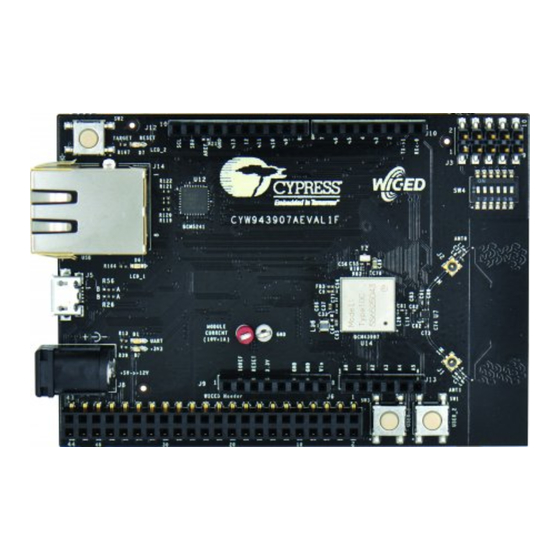Table of Contents
Advertisement
Quick Links
AN237426
AIROC™ CYW9x907 Wi-Fi connectivity processor
low-power modes
About this document
Scope and purpose
This application note introduces low-power modes in AIROC™ CYW9x907 Wi-Fi connectivity processors and
describes how to adjust the build of an application to use low-power modes.
Intended audience
This application note is for anyone who uses low-power support for an application running on one of the
following kits:
1. CYW943907AEVAL1F
2. CYW954907AEVAL1F
Application note
Please read the sections "Important notice" and "Warnings" at the end of this document
002-37426 Rev. **
www.infineon.com
2023-05-11
Advertisement
Table of Contents

Summary of Contents for Infineon AIROC CYW9 907 Series
-
Page 1: About This Document
This application note is for anyone who uses low-power support for an application running on one of the following kits: 1. CYW943907AEVAL1F 2. CYW954907AEVAL1F Application note Please read the sections “Important notice” and “Warnings” at the end of this document 002-37426 Rev. ** www.infineon.com 2023-05-11... -
Page 2: Table Of Contents
AIROC™ CYW9x907 Wi-Fi connectivity processor low-power modes Table of contents Table of contents About this document ........................1 Table of contents ..........................2 Introduction .......................... 3 Low-power mode features ...................... 4 Application processor (APP CPU) ......................4 Wireless LAN processor (WLAN CPU) ...................... 4 APP CPU low-power mode settings ................... -
Page 3: Introduction
AIROC™ CYW9x907 Wi-Fi connectivity processor low-power modes Introduction Introduction The AIROC™ CYW9x907 Wi-Fi connectivity processor supports all rates specified in the IEEE 802.11 b/g/n specifications and includes an Arm® Cortex®-based applications processor, a single-stream IEEE 802.11n MAC/baseband/radio, a dual-band (2.4 GHz/5 GHz) transmit power amplifier (PA), and a receive low noise amplifier (LNA). -
Page 4: Low-Power Mode Features
AIROC™ CYW9x907 Wi-Fi connectivity processor low-power modes Low-power mode features Low-power mode features This MCU platform has two CPUs: 1. Application processor (APP CPU) 2. Wireless LAN processor (WLAN CPU) Power modes for both the CPUs are independent and can be used together or separately. Application processor (APP CPU) The APP CPU runs the user application. -
Page 5: App Cpu Low-Power Mode Settings
AIROC™ CYW9x907 Wi-Fi connectivity processor low-power modes APP CPU low-power mode settings APP CPU low-power mode settings The setting for the APP CPU low-power mode is in <app_root_directory>/bsps/ TARGET_APP_CYW943907AEVAL1F/cybsp.h. Table 1 APP CPU low-power settings Define Notes CY_CFG_PWR_MODE_ACTIVE Active mode – do not go into any sleep mode CY_CFG_PWR_MODE_SLEEP Sleep mode –... - Page 6 AIROC™ CYW9x907 Wi-Fi connectivity processor low-power modes APP CPU low-power mode settings Table 2 Hibernation wakeup source Define Notes CYHAL_SYSPM_HIBERNATE_WDT Configures the WDT interrupt as the wakeup source. This is the only wakeup source currently supported. Code Listing 2 Calling hibernate from main() #include "cyhal_syspm.h"...
-
Page 7: Wlan Cpu Low-Power Modes
AIROC™ CYW9x907 Wi-Fi connectivity processor low-power modes WLAN CPU low-power modes WLAN CPU low-power modes The WLAN CPU runs a fixed firmware image that is loaded at power-up of the device. The WLAN CPU runs independently of the APP CPU and talks to the APP CPU through a dedicated M2M DMA channel. The application running on the APP CPU can send commands to the WLAN CPU that allows the WLAN CPU to determine when to go into a low-power mode. -
Page 8: Hal Functions
AIROC™ CYW9x907 Wi-Fi connectivity processor low-power modes HAL functions HAL functions The Hardware Abstraction Layer (HAL) API provides functions for applications to affect the power mode of the device. See Hardware Abstraction Layer power management API for more information. When Sleep or DeepSleep occurs, the code hits an Arm® Cortex®-R4 “Stop and Wait for Interrupt” (SWI) instruction. -
Page 9: Single-Threaded Application Using Tickless Sleep Or Deepsleep
AIROC™ CYW9x907 Wi-Fi connectivity processor low-power modes HAL functions 5.1.2 Single-threaded application using tickless Sleep or DeepSleep The following code listings show the steps to use the low-power timer (lptimer) and the tickless sleep functions to enable the APP CPU to enter Sleep or DeepSleep mode for a specified time. The APP CPU Sleep mode may end earlier than the specified time due to an interrupt. -
Page 10: Multi-Threaded Applications
AIROC™ CYW9x907 Wi-Fi connectivity processor low-power modes HAL functions Multi-threaded applications In multi-threaded applications, the user application does not call the sleep functions directly. They are called from the RTOS in the idle task. Code Listing 10 Code Listing 11 show how to enable the RTOS to call Sleep and DeepSleep mode. -
Page 11: References
AIROC™ CYW9x907 Wi-Fi connectivity processor low-power modes References References Hardware Abstraction Layer Power Management API Infineon AN214828 Power Consumption Measurements Application Note Low Power Current Measurements Using CYW943907AEVAL1F Application note 002-37426 Rev. ** 2023-05-11... -
Page 12: Revision History
AIROC™ CYW9x907 Wi-Fi connectivity processor low-power modes Revision history Revision history Document Date Description of changes revision 2023-05-11 Initial release. Application note 002-37426 Rev. ** 2023-05-11... -
Page 13: Disclaimer
Infineon Technologies hereby Infineon Technologies’ products may not be used in disclaims any and all warranties and liabilities of any applications where a failure of the product or any any kind (including without limitation warranties of © 2023 Infineon Technologies AG.














Need help?
Do you have a question about the AIROC CYW9 907 Series and is the answer not in the manual?
Questions and answers